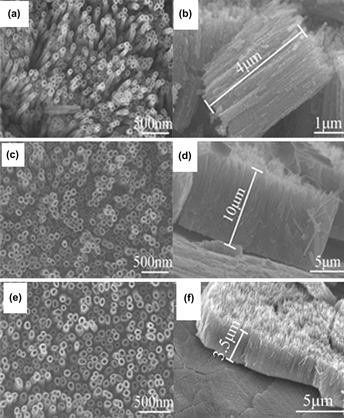Crossref Citations
This article has been cited by the following publications. This list is generated based on data provided by
Crossref.
Passalacqua, Rosalba
Perathoner, Siglinda
and
Centi, Gabriele
2015.
Use of modified anodization procedures to prepare advanced TiO2 nanostructured catalytic electrodes and thin film materials.
Catalysis Today,
Vol. 251,
Issue. ,
p.
121.
Lan, Zhang
Wu, Wanxia
Zhang, Sheng
Que, Lanfang
and
Wu, Jihuai
2016.
An efficient method to prepare high-performance dye-sensitized photoelectrodes using ordered TiO2 nanotube arrays and TiO2 quantum dot blocking layers.
Journal of Solid State Electrochemistry,
Vol. 20,
Issue. 10,
p.
2643.
Liu, Yan
Li, Zhe
Green, Michael
Just, Michael
Li, Yang Yang
and
Chen, Xiaobo
2017.
Titanium dioxide nanomaterials for photocatalysis.
Journal of Physics D: Applied Physics,
Vol. 50,
Issue. 19,
p.
193003.
Liu, Yan
Su, Dong
Zhang, Yanzong
Wang, Lilin
Yang, Gang
Shen, Fei
Deng, Shihuai
Zhang, Xiaohong
and
Zhang, Shirong
2017.
Anodized TiO2 nanotubes coated with Pt nanoparticles for enhanced photoelectrocatalytic activity.
Journal of Materials Research,
Vol. 32,
Issue. 4,
p.
757.
Ahmadi, Amir
and
Wu, Tingting
2019.
Electrocatalytic reduction of nitrobenzene using TiO2 nanotube electrodes with different morphologies: Kinetics, mechanism, and degradation pathways.
Chemical Engineering Journal,
Vol. 374,
Issue. ,
p.
1241.
Yu, Chengtao
Zhang, Jingyi
Yang, Hexu
Zhang, Ling
and
Gao, Yu
2019.
Enhanced photovoltaic conversion efficiency of a dye-sensitized solar cell based on TiO2 nanoparticle/nanorod array composites.
Journal of Materials Research,
Vol. 34,
Issue. 07,
p.
1155.
Abdellah, Islam M.
and
El-Shafei, Ahmed
2020.
Synthesis and characterization of novel tetra anchoring A2-D-D-D-A2 architecture sensitizers for efficient dye-sensitized solar cells.
Solar Energy,
Vol. 198,
Issue. ,
p.
25.
Lv, Chunmei
Wang, Xiuwen
Li, Qun
Li, Chunyan
Ouyang, Qiuyun
Liu, Yongjun
and
Qi, Lihong
2021.
Template-assisted synthesis of porous TiO2 photoanode for efficient dye-sensitized solar cells.
Journal of Materials Research,
Vol. 36,
Issue. 3,
p.
688.
Rojviroon, Thammasak
Rojviroon, Orawan
Sirivithayapakorn, Sanya
and
Angthong, Sivakorn
2021.
Application of TiO2 nanotubes as photocatalysts for decolorization of synthetic dye wastewater.
Water Resources and Industry,
Vol. 26,
Issue. ,
p.
100163.
Zakir, O.
Ait-Karra, A.
Idouhli, R.
Khadiri, M.
Dikici, B.
Aityoub, A.
Abouelfida, A.
and
Outzourhit, A.
2023.
A review on TiO2 nanotubes: synthesis strategies, modifications, and applications.
Journal of Solid State Electrochemistry,
Vol. 27,
Issue. 9,
p.
2289.
Çalışkan, Berrak
and
Şayan, Enes
2025.
Review on TiO2 nanotubes in dye-sensitized solar cells: electrochemical anodization and hydrothermal method.
Journal of Solid State Electrochemistry,
